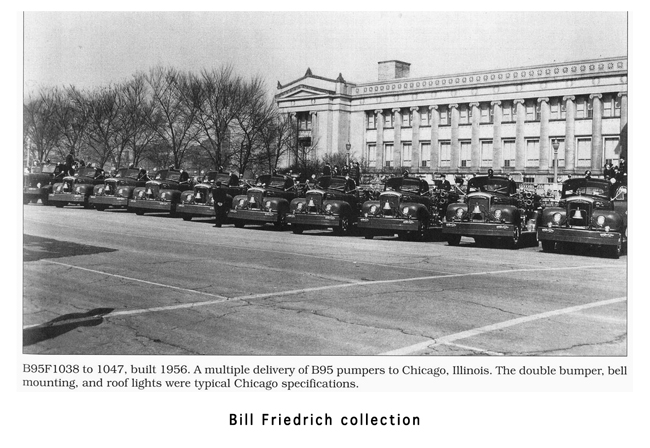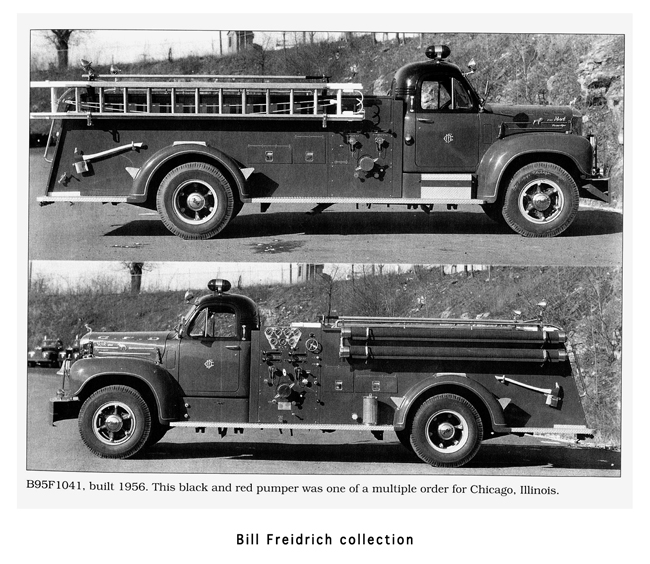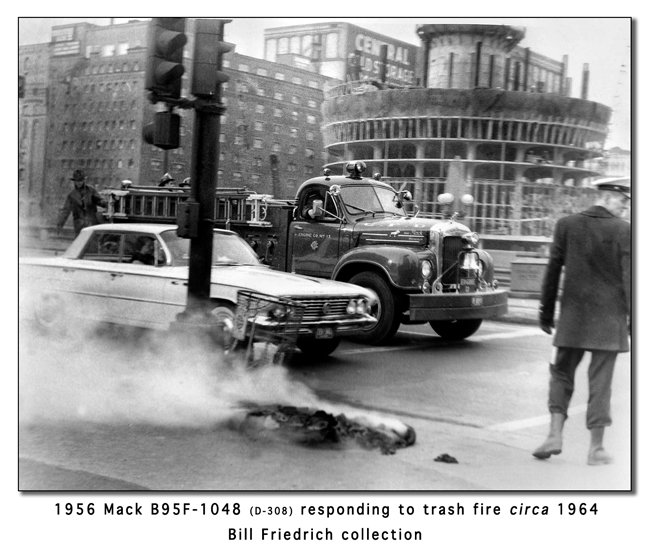More from the collection of Bill Friedrich. The 1956 Mack B-Model engines that were delivered to the Chicago Fire Department.

Bill Friedrich collection

Bill Friedrich collection

Chicago Engine 13 on Dearborn Street circa 1964. Bill Friedrich collection






























#1 by John on November 12, 2015 - 8:59 PM
I remember riding on Eng. 122 as a teenager in the early 70’s and they had one of these Macks with the booster tank. What they had for a hose line was 100′ of garden hose with a twist-type garden adjustable nozzle. They used this primarily for rubbish, dumpsters, small auto fires. The 1-1/2″ was used for fully involved autos and such, figuring with the elkhart adj. fog nozzle at 75gpm, you had just about 2 minutes of tank water so your pipe guy had to use it conservatively.
#2 by Bill Post on July 27, 2012 - 2:25 AM
Mike, yes there is a way to find out approximately when the conversions of the two International High Pressure rigs were about to take place. Off hand I would suggest the archives at the Greater Chicagoland Fire Museum. It’s been months since I’ve been to the museum so I don’t know if the archives are open to the public yet. I believe that they were supposed to be put on the second floor, but there was work to be done up there so I really don’t know if the second floor is open yet.
When the Fire Museum was at St. Gabriels Parish the archives had at large classroom to themselves and the collection was quite impressive. That is probably the best resource for getting the exact dates and records to find out when the 40-foot Pitmans were ordered.
Here is what I know about them. The squad bodies were built by the Erlinder Company and the Snorkel itself was a Strato Tower. I don’t know if Strato Tower was bought out, merged with another company, or if they went out of business. Chicago had two additional Strato Tower Snorkels that were assigned to Snorkels 6 and 7 which were in the 65 to 70-foot range.
Snorkel Squads 1 and 2 were essentially put in service as twin companies (one for the North Side and one for the South Side). Even though SS-1 went in service about a year before SS-2, Snorkel Squad 2 was built and delivered at either the same time or shortly after Snorkel Squad 1 was delivered.
You are correct that Snorkel Squad 1 was given G115 (not 155) which was High Pressure Wagon 4’s former rig, and they were out of service when they were sent to have a new body and Snorkel installed. However G116 which had been assigned to High Pressure Wagon 1 and was operating from Engine 1’s station in 1961 had been in service until Second Deputy Fire Marshall Chief Harry Mohr had ordered it taken out of service on June the 20th 1961. It was rebuilt and put in service as Snorkel Squad 2. I really don’t know if rig G115 was sent to have the Snorkel Squad body installed at the exact same time as rig G116, but I am willing to bet that they were sent at pretty close to the same time.
I have been assuming that Snorkel Squads 1 and 2 were sent to the manufacturer to have the Snorkels and their bodies installed but I could be wrong.
I don’t totally buy into your theory of SS-1 and SS-2 being put in service because of the Hubbard Street fire and building collapse, because most of today’s building collapse technology such a motion detectors and re-enforced lifting bags were still years away from being regularly used by fire departments. The spreaders and jaws weren’t even developed yet. The technology at the time was various sizes and types of Porto-Power jacks and attachments.
The Chicago Fire Department was lacking in various types of basic power tools at the time however. Chicago truck and conventional squad companies didn’t carry power saws or generators on them and the real reason why Commissioner Quinn had put the Snorkel Squads in service was because the CFD was running behind the times in some basic fire fighting and rescue technology. He wanted to have some state of the art equipped and trained heavy rescue squads on the CFD. We had 13 conventional squad companies in service at the time, and while they were using nice looking rigs (mainly 1954, 52 and 49 Auto Cars plus one 1949 Mack) these were limited in space. The equipment that they carried was basically the same types of equipment that they carried in the 40s and even the 30s. The squads carried a few types of chest-mounted breathing masks, some of which were Chemox and some Mc Caa types. They also had a few filter type masks called Burell Masks, but they didn’t carry the newer back mounted air packs that most other big city fire departments had been using by then.
If they needed to use power saws or power drills, they had to special call a Light Wagon, because that equipment was only carried on the light wagons. Another option was to call for the Civil Defense Emergency Service which also carried some power tools. The squad companies did carry cutting torches however.
The Snorkel Squads carried power tools, self-contained air packs, acid suits, asbestos suits, foam equipment, and various types of dry powder extinguishing agents. They also carried scuba diving suits, tanks, and an inflatable life raft. Additional equipment included Porto-Power jacks and other equipment that was found on the conventional squads except more of it. They even carried a multi-versal three way portable turret nozzle and an electric smoke ejector fan on the Fog Pressure Unit.
So the Snorkel Squads were much more thoroughly equipped and it’s just that I’m pretty sure that they would have been put in service even if the Hubbard Street fire hadn’t happened.
Incidentally Mike, the Chicago Fire Department did have an air compressor at the time which could have been used to operate air hammers at the scene of the Hubbard Street fire and building collapse. The Civil Defense Emergency Service also had restored army surplus lifting and power equipment. I’m sure that the city had also used some front-end loaders to clear the debris after searching the rubble for survivors.
#3 by Bill Post on July 26, 2012 - 10:55 PM
Scott the famous 888 lights were added around 1958/59.
Our new Battalion Chief station wagons that were delivered in 1958 had twin 888 lights on both sides of the hood and the Fords that were delivered in 1960 had them on the roof with the “Football” red light in the center. By 1960 most of the rigs had them.
#4 by Scott on July 26, 2012 - 7:26 PM
When was the “888” added to the bell for the Macks? CFD spec added at the shop? Love those lites, still around and work great for a reason!
#5 by Mike McAuliffe on July 26, 2012 - 2:35 PM
Thanks Bill, your knowledge of CFD rigs is very impressive. If you don’t mind my asking an unrelated question, is there any way to find out when the shops started converting the 1956 International Harvester rig G-155, formerly known as High Pressure Wagon 4, into SS-1? I know the snorkel squad went in service in October 1962. I am attempting to determine, if possible, when Quinn made the decision to establish the snorkel squad. I was thinking that the day they started the conversion, or possibly the day that the shops ordered the snorkel boom from Pitman, would be the closest thing to an offical record.
I have a theory that the 1961 Hubbard Street fire and also the 1962 O’Brien and Hoff LODD fire played a role in influencing Quinn to establish the snorkel squad. Both involved building collapses and firefighter entrapment. In both cases, the rescue equipment and tools available at the scene were of limited value. It is just a theory.
Thank you for your time
Thanks in advance.
#6 by Bill Post on July 26, 2012 - 11:43 AM
First I would like to make a correction in regards to Engine Company 25 and Engine 27. While Engine 25 did receive Engine 27’s 1956 Mack in 1963, Engine Company 27 did remain in service until January 16, 1965. Engine 25 was given Engine 27’s rig primarily because the Dan Ryan expressway was opened shortly before the reassignment.
Mike you are correct about the inch and a half lines that were used off of the booster tank, because the reels weren’t added until years later. In fact, not all of the 1956 Macks had booster reels added as far as I know. Engine 78 had a booster reel installed and perhaps a few others? After we started getting new engines delivered beginning in late 1966 which were equipped with larger capacity (500 gallon) booster tanks, several of the 1956 Macks were shifted around as more of the newer model engines were put in service.
That was Marina city in the background of the shot of Engine 13 arriving at the burning rubbish fire on Wacker drive and State street.
As close as Engine 13’s house was to Marina City at the time (they were just across the river on Dearborn south of Wacker) there was another fire station equally as close and that was Engine 11 and Truck 9 on Hubbard east of State Street, a half block north of Marina City.
#7 by Mike McAuliffe on July 26, 2012 - 9:45 AM
Bill, were the booster hose reels added on years later? Before that, did they did they have to use a one and half inch hose?
The engine shown on Wacker Drive in front of the Marina Towers building that is under construction is probably Engine 13. Do you agree?
Thanks for the detailed information on these rigs.
#8 by Bill Post on July 26, 2012 - 2:05 AM
The 1956 Mack B/95 engines were all built with 200-gallon booster tanks. These were the only engines on the CFD at the time that had been built with booster tanks. These engines were generally assigned to companies where the booster tanks could be put to good use, such as with companies that were near expressways or near Lake Shore Drive. Also, they went to companies that had large brush areas to cover like Engine 81 and 62 on the far south side. When these rigs were first put in service, the expressway system in Chicago was just beginning to be developed, and the Dan Ryan, Stevenson, and Kennedy expressways were not opened yet. When the highways were opened, a few of the rigs were reassigned but many of them had remained with their original companies for at least the first 10 years of their service lives. Examples were Engines 108, 78, 113, 13, 60, 87, and 62. Engine 25, which was at the new Fire Academy at the time, had been reassigned Engine 27’s rig in 1963 after Engine 27 was taken out of service. One of them had also been assigned to Engine 21 whose last assignment was at Meigs Field before being taken of service in 1967. Engine 122 was reassigned Engine 81’s rig after the Dan Ryan expressway was opened.
These Macks were the last engines that the CFD purchased in the 1950s. It was another 10 years (in 1966) before the Chicago Fire Department started purchasing new engines again.